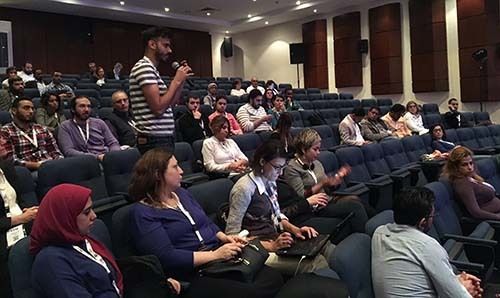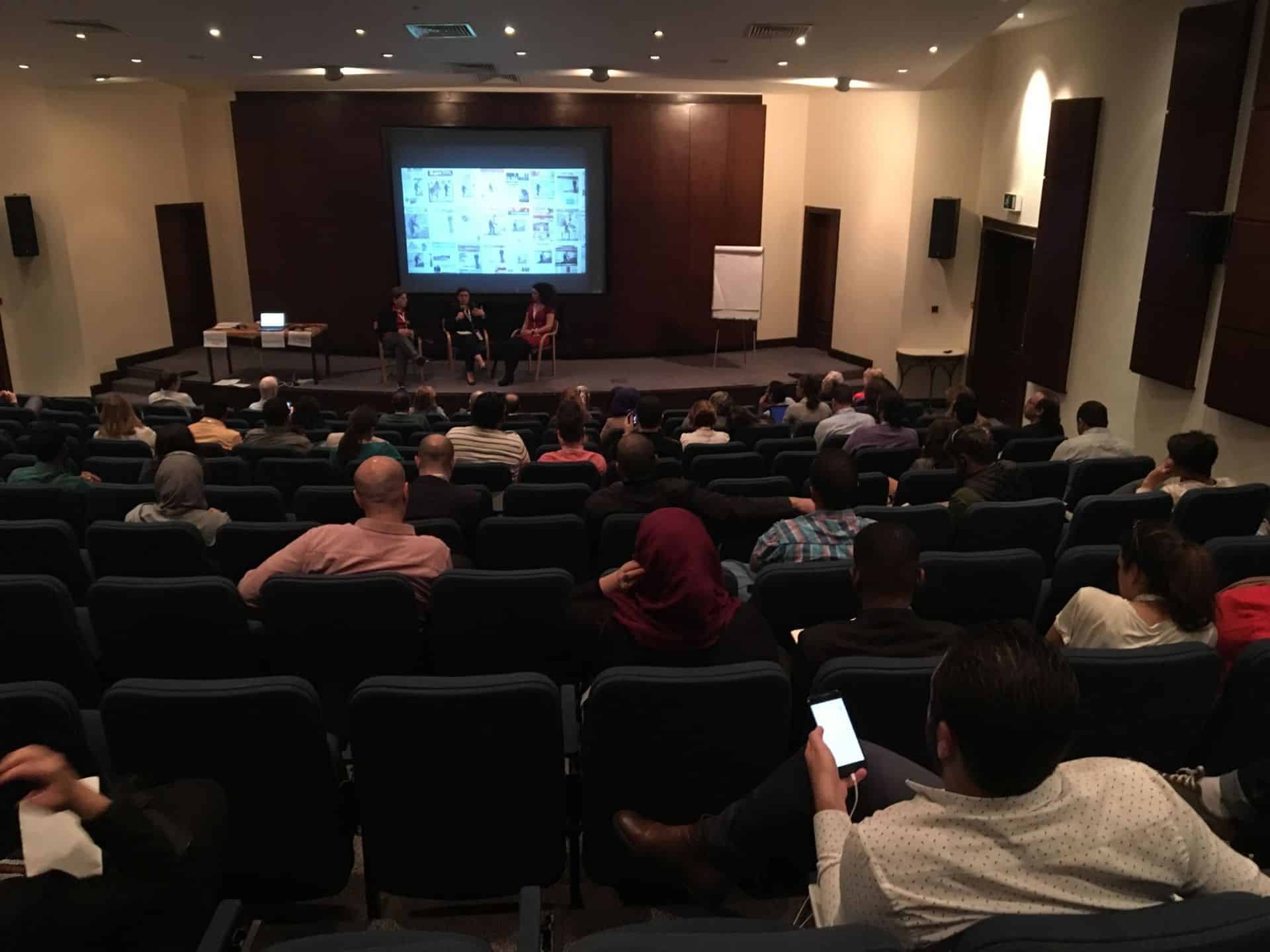A punch in the gut is how it feels seeing images of a child in distress, or worse, as a lifeless body on a faraway beach torn away from his family and home.
It’s doubly painful, and difficult, when the person deciding to publish such images must choose which photos to use and how graphic they can be for various audiences across multiple media platforms.
These weighty decisions may lead to images becoming icons and symbols representing all other victims.
But such pictures can also be (mis)used by politicians to score points and advance their own agendas.
The topic made for an animated discussion during “Movie Night” hosted by the Ethical Journalism Network (EJN) at this month’s Arab Reporters for Investigative Journalism’s(ARIJ) annual conference in which I participated as a panelist.

Audience at the Sea of Pictures film screening at ARIJ debate the ethics of photo publishing (Photo: EJN)
The movie in question was “A Sea of Images,” a documentary on how media tackle migrants and refugees from the Middle East and Africa fleeing their troubled lands in a perilous journey across the Mediterranean Sea to Europe.
The film, produced by Misja Pekel and Maud van de Reijt, is part of a series for Dutch public television that examined the connection between media and public opinion.
Although media have been inundated with images of refugees on unseaworthy vessels (many drowning) for the past several years, the picture of Syrian toddler Aylan Kurdi lying face down on a Turkish beach is seared in our minds.
Nilufer Demir, a photographer with Turkey’s DHA news agency, shot the famous Kurdi pictures. Her boss Ugur Cebeci decided to distribute them uncensored on September 2, 2015.
Cebeci said the boy looked asleep and the sea behind him was calm. “Which part should we censor? How should we distribute it?” he asked.
He opted not to censor and left the decision to editors in other media.
But DHA did send a footnote, he said. “It was too late for us to ask this innocent child for permission.”
The famous photo eventually went viral and was picked up by media worldwide after being posted on the agency’s website.

The audience discusses the ethical issues raised in “Sea of Pictures” at the ARIJ summit in Jordan. (Photo: EJN)
“In the first two hours you get international journalists sharing it, and then in that same two hours you get the emergency director of Human Rights Watch Peter Boukaert sharing it from Switzerland,” said Farida Vis, director at the University of Sheffield’s Visual Social Media Lab who examined how the photo went viral in record time.
She pointed to a chain reaction, saying that in the first three hours a tweet by Liz Sly, the Washington Post’s Beirut bureau chief, was shared over 7,000 times, which is when the picture really went viral.
“I very rarely use graphic images in my work but in the case of the picture of Aylan Kurdi, it was important to shock the world because shocking things are happening in the Mediterranean and people needed a wake-up call,” Boukaert said.
The picture would eventually wind its way to the World Press Photo 2016 contest along with 80,000 other entries. The jury members were overwhelmed by the choices representing a jarring amount of raw human emotions.
Judges saw repetitions of the theme in hundreds of images shot from different angles by various photographers at the same location, which created a problem of what to choose as the best. Kurdi’s picture wasn’t selected.
According to the film’s producers, only a few of the endless stream of refugee pictures make it to the front pages of newspapers.
“While it’s really important to highlight the severity of the situation and the gravity of the story, you also don’t want to repel your readers, and turn them away from the heart of the matter,” Fiona Shields, The Guardian newspaper’s picture editor, said.
Refugee fatigue, I argued in the discussion following the film’s showing, can affect journalists’ and editors’ judgment in their choice and dissemination of images, with ethics falling by the wayside.
Aidan White, veteran journalist and director of the Ethical Journalism Network, said three of the Aylan Kurdi pictures were published around the world, but photos could be used in different ways to tell different narratives.
“What that reveals, is that although the pictures are dramatic and important, in the end it’s the context in which the pictures are used by journalists,” White explained.
Farida Vis said not everybody agreed on what they saw in the Kurdi image since photos have always had the possibility of triggering different interpretations and becoming battlegrounds of perception.
The ethical use of images depicting migrants, refugees and vulnerable people in the media, and what impact they have on public policy, will continue to trigger debate so long as conflicts, economic and natural disasters cause massive population displacement.
This article was originally published on Magda Abu Fadil’s Huffington Post blog. Republished with permission.
Main photo: On the second evening of the Arab Reporters for Investigative Journalism conference in Jordan the Ethical Journalism Network hosted a screening of “Sea of Pictures”. On the Panel after the film, EJN trustee Zahera Harb, EJN Adviser Magda Abu Fadil and Hunadah Al Hariri from the Syrian Centre of Media and Freedom of Expression. (Photo: EJN)